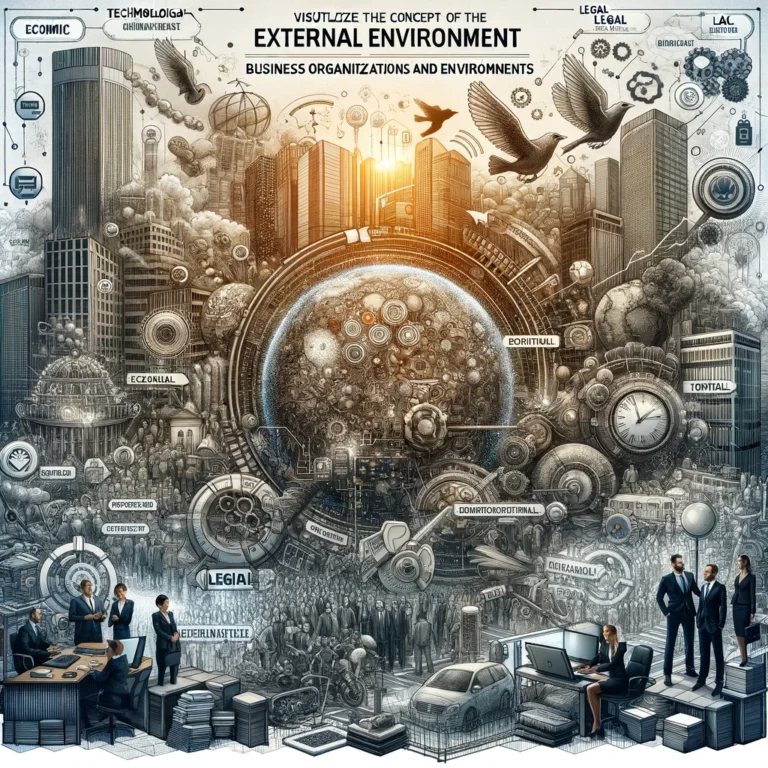The external environment of a business encompasses all outside factors and influences that impact the organization’s operations, strategies, and overall success. These factors can be broadly categorized into the macro environment, which includes wider societal forces, and the industry or micro-environment, which pertains to the immediate competitive surroundings. Understanding the external environment is crucial for businesses to navigate challenges, capitalize on opportunities, and devise strategic plans that are resilient and adaptive. This comprehensive analysis explores the components of the external environment, supported by industry examples, to provide IB Business & Management students with insights into its significance in strategic business planning.
Macro Environment
The macro environment is analyzed through frameworks such as PESTEL (Political, Economic, Social, Technological, Environmental, and Legal factors), which help businesses assess broader societal trends and forces.
Political: Political factors include government policies, trade tariffs, and political stability, which can significantly impact business operations.
- Example: Apple Inc. faces challenges and opportunities in navigating the US-China trade tensions, affecting its supply chain and market access in China.
Economic: Economic factors encompass economic growth, inflation rates, and currency exchange rates, influencing consumer spending and business investment.
- Example: During the 2008 financial crisis, Toyota had to adjust its strategies due to reduced consumer spending and disruptions in the global automotive market.
Social: Social factors involve cultural trends, demographic changes, and consumer lifestyles, affecting demand for products and services.
- Example: Beyond Meat capitalizes on the growing social trend towards plant-based diets, meeting consumer demand for sustainable and ethical food choices.
Technological: Technological factors include innovations, digital transformation, and technological infrastructure, driving competitive advantage and operational efficiency.
- Example: Netflix’s success is partly due to its technological innovation in streaming services, transforming how people consume media and entertainment.
Environmental: Environmental factors concern ecological and environmental aspects such as climate change and sustainability practices.
- Example: Patagonia, an outdoor clothing brand, integrates environmental sustainability into its business model, appealing to environmentally conscious consumers.
Legal: Legal factors involve regulations and laws that govern business operations, including labor laws, health and safety regulations, and consumer protection laws.
- Example: The introduction of the GDPR in the European Union required companies like Facebook to overhaul their data privacy practices, impacting how they collect and process user data.
Industry or Micro-Environment
The industry environment, analyzed using tools like Porter’s Five Forces, includes the competitive dynamics within the industry, such as rivalry among existing competitors, the threat of new entrants, the bargaining power of suppliers, the bargaining power of customers, and the threat of substitute products or services.
- Example: In the highly competitive airline industry, companies like Emirates navigate intense rivalry, fluctuating fuel prices (supplier power), price-sensitive customers, threats from budget airlines (substitutes), and barriers to entry such as high capital requirements.
External factors outside influences that can impact a business such as laws, market trends or political changes.
A civil war for example could significantly harm businesses selling luxury goods as the demand will drop severely.
In order to monitor all these changes in the external environment, businesses conduct a combined SWOT and PEST analysis. These analyses take external factors into consideration that may affect economic activities, so that businesses are able to set SMART objectives.
PEST analysis evaluates opportunities & threats on Political, Economic, Social and Technological factors.
A PEST analysis is a strategic tool used to understand market growth or decline, business position, potential, and direction for operations. By examining the Political, Economic, Social, and Technological factors, businesses can gain insights into the external macro-environmental factors that might impact their operations and strategy. This comprehensive analysis is crucial for businesses to anticipate future trends, adapt to changes, and make informed decisions. Here, we explore each component of the PEST analysis in detail, along with industry examples, to provide IB Business & Management students with a deep understanding of how businesses navigate their external environments.
Political Factors
Political factors include government policies, political stability or instability in foreign markets, foreign trade policy, tax policy, labor law, environmental law, trade restrictions, tariffs, and political trends.
Impact and Example: Political decisions can significantly impact a company’s operations and profitability. For instance, Apple Inc. navigates complex global political landscapes, including trade relations between the United States and China. Tariffs imposed on goods manufactured in China can increase production costs for Apple’s products, impacting its profit margins. Apple must continuously monitor political developments to strategize and mitigate risks associated with trade policies and tariffs.
Economic Factors
Economic factors encompass economic growth, interest rates, exchange rates, inflation rate, economic performance, unemployment rates, and consumer confidence.
Impact and Example: Economic conditions directly affect a company’s ability to attract customers and achieve profitability. Toyota Motor Corporation faces economic challenges during recessions when consumer demand for new vehicles declines. The company must adapt by managing costs, adjusting production rates, and potentially focusing on more affordable car models or markets with stronger economic growth to maintain its market position.
Social Factors
Social factors involve cultural aspects, health consciousness, population growth rate, age distribution, career attitudes, and emphasis on safety. Changes in social trends can impact the demand for a company’s products and services.
Impact and Example: Beyond Meat, a company producing plant-based meat substitutes, benefits from shifting social trends toward health consciousness, environmental sustainability, and ethical concerns about animal welfare. The growing consumer interest in plant-based diets represents an opportunity for Beyond Meat to expand its market presence and product offerings.
Technological Factors
Technological factors include technological aspects like R&D activity, automation, technology incentives, and the rate of technological change. They can create opportunities for businesses to pursue new market segments, innovate products and services, and improve operational efficiencies.
Impact and Example: Netflix transformed the entertainment industry by capitalizing on technological advancements in streaming video technology and broadband internet access. By offering a convenient, on-demand streaming service, Netflix disrupted traditional television and DVD rental businesses, demonstrating how companies can leverage technological factors to revolutionize industries.
Application of PEST Analysis
The PEST analysis is a strategic framework that allows businesses to identify external opportunities and threats arising from political, economic, social, and technological factors. This analysis helps businesses adapt to environmental changes, align their strategies to external conditions, and gain a competitive edge.
For IB Business & Management students, understanding the application of PEST analysis is key to grasping how strategic tools inform decision-making processes. It exemplifies the necessity for businesses to not only react to but also anticipate changes in their external environment, ensuring long-term sustainability and growth.
Examples of opportunities
Political: political situation in the country is very stable.
Economic: the economy is booming and people have growing income.
Social: increasing average living conditions means more people can afford luxury items.
Technological: faster 4G mobile internet network allows development of more complex apps like voice recognition.
Political: stricter employment laws increases business risk.
Economic: high competition in particular market segment.
Social: healthier lifestyle of consumers reduces sale of soft drinks.
Technological: the invention of a better medicine obsoletes the current.
STEEPLE the same analysis as is done in PEST, but also includes Legal, Environmental and Ethical.
Note: If the exam asks you to design a SWOT analysis, this automatically means you will need to do a PEST analysis as well in order to be able to properly analyse the external environment. Application is key – you have to look carefully through the case study in order to be able to create a SWOT analysis explicitly applicable to the company in the case study, and justify your answers at all times! You have to explain why something is a strength, weakness, opportunity or a threat. Without arguments your answer will not be considered complete.
In the dynamic landscape of business strategy, the integration of SWOT (Strengths, Weaknesses, Opportunities, and Threats) and PEST (Political, Economic, Social, and Technological) analyses stands as a pivotal approach for comprehensive external and internal environment assessment. This detailed exploration aims to delineate the interconnectedness of SWOT and PEST analyses, emphasizing the importance of their application in crafting well-rounded strategic insights. By dissecting the components of each analytical tool and illustrating their application with a hypothetical industry example, this discourse seeks to provide IB Business & Management students with a nuanced understanding of strategic analysis.
The Synergy of SWOT and PEST Analyses
SWOT Analysis serves as a fundamental tool for identifying and understanding the internal strengths and weaknesses of an organization, alongside the external opportunities and threats it faces. This analysis facilitates a structured approach to strategic planning, enabling businesses to capitalize on their strengths, address weaknesses, seize opportunities, and mitigate threats.
PEST Analysis, on the other hand, offers a macro-environmental perspective, focusing on the Political, Economic, Social, and Technological factors that influence the business environment. PEST analysis aids in the external examination of the conditions that could impact the organization’s performance and strategic options.
Integrating SWOT with PEST analyses ensures a holistic strategic assessment, enabling businesses to align their internal capabilities and resources with external environmental factors. This integrated approach not only highlights the current strategic position but also aids in forecasting future trends and challenges.
Application in Strategic Planning: A Hypothetical Industry Example
Company: TechStart Inc., a burgeoning technology firm specializing in renewable energy solutions.
PEST Analysis
Political: Increasing global emphasis on green energy policies presents an opportunity for government contracts and subsidies for renewable energy projects.
Economic: Economic recovery post-recession boosts corporate and consumer spending on sustainable technologies, offering a fertile market for TechStart’s innovations.
Social: Growing public awareness and concern for environmental issues drive demand for renewable energy solutions, aligning with TechStart’s mission and product offerings.
Technological: Rapid advancements in renewable energy technologies provide TechStart with opportunities for innovation and development, although they also pose a threat of obsolescence.
SWOT Analysis
Strengths: TechStart boasts a strong R&D department, a creative workforce, and a solid reputation for quality and innovation in renewable energy technology.
Weaknesses: Limited market presence compared to established competitors and reliance on venture capital funding indicate financial vulnerability and constraints on rapid expansion.
Opportunities: Expansion into emerging markets, partnerships with established energy companies, and diversification of product lines to include solar and wind energy storage solutions.
Threats: Intense competition from larger firms with more resources, potential regulatory changes affecting renewable energy subsidies, and the fast-paced nature of technological innovation.
Justification and Integration
The PEST analysis reveals an external environment ripe with opportunities for a company like TechStart, driven by political support, economic recovery, social trends favoring sustainability, and technological advancements. However, the analysis also highlights potential threats from regulatory changes and rapid technological evolution.
The SWOT analysis, informed by the PEST insights, identifies TechStart’s internal strengths, such as its innovation capabilities, which it can leverage to capitalize on external opportunities like market expansion and technological advancements. Simultaneously, it acknowledges internal weaknesses and external threats, underscoring the need for strategic initiatives to bolster market presence and financial stability.
Frequently Asked Questions: The External Environment & Technical Errors
What is the External Environment (in a business context)?
What are the key factors or components of the External Business Environment?
- Political: Government policies, political stability, trade regulations, tax policies.
- Economic: Inflation rates, interest rates, unemployment levels, consumer spending power, economic growth.
- Social: Demographics, cultural trends, lifestyle changes, consumer attitudes, social values.
- Technological: New inventions, automation, digital infrastructure, R&D activities, pace of technological change.
- Legal: Laws and regulations related to employment, health & safety, consumer protection, data privacy, competition.
- Environmental: Climate change, environmental regulations, resource availability, sustainability concerns.
What is the 'externally-managed-environment' error (specifically in Python/pip)?
How can I fix the 'externally-managed-environment' error when using pip?
- Use a Virtual Environment: This is the standard and best practice. Create a dedicated environment for your project using `venv` (built into Python 3.3+) or `conda`. Activate the virtual environment, and then use `pip install` within it. Example: `python -m venv myenv`, `source myenv/bin/activate` (Linux/macOS) or `myenv\Scripts\activate` (Windows), then `pip install package_name`.
- Install User-Locally: If a virtual environment isn't practical (e.g., for simple scripts or utilities), you can install packages only for your user account using `pip install --user package_name`. These packages go into a user-specific directory.
- (Last Resort) Override: You can force the installation using `pip install package_name --break-system-packages`. **Use this with extreme caution** as it can potentially destabilize your system's Python environment if not managed carefully. It's generally not recommended unless you understand the risks and have a specific reason.
How does the External Environment relate to the Internal Environment?
- The **External Environment** presents opportunities and threats that the organization must identify and respond to.
- The **Internal Environment** consists of the organization's strengths and weaknesses (resources, culture, capabilities).






